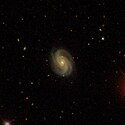NGC 5478
| Galaxie Daten von NGC 5478 | |
|---|---|
 | |
| SDSS-Aufnahme | |
| AladinLite | |
| Sternbild | Jungfrau |
| Position Äquinoktium: J2000.0, Epoche: J2000.0 | |
| Rektaszension | 14h 08m 08,5s[1] |
| Deklination | -01° 42′ 08″[1] |
| Erscheinungsbild | |
| Morphologischer Typ | SAB(s)bc / HII[1] |
| Helligkeit (visuell) | 13,7 mag[2] |
| Helligkeit (B-Band) | 14,5 mag[2] |
| Winkelausdehnung | 1,1′ × 0,8′[1] |
| Positionswinkel | 37° |
| Flächenhelligkeit | 13,4 mag/arcmin²[2] |
| Physikalische Daten | |
| Rotverschiebung | 0.025147 ±0.000097[1] |
| Radialgeschwindigkeit | 7539 ± 29 km/s[1] |
| Hubbledistanz vrad / H0 | (335 ± 23) · 106 Lj (102,8 ± 7,2) Mpc [1] |
| Durchmesser | 110.000 Lj |
| Geschichte | |
| Entdeckung | Wilhelm Herschel |
| Entdeckungsdatum | 23. März 1789 |
| Katalogbezeichnungen | |
| NGC 5478 • UGC 9034 • PGC 50430 • CGCG 018-055 • MCG +00-36-019 • IRAS 14055-0127 • 2MASX J14080854-0142081 • GC 3788 • H III 762 • LDCE 1030 NED007 | |
NGC 5478 ist eine Balkenspiralgalaxie mit ausgedehnten Sternentstehungsgebieten vom Hubble-Typ SAB(s)bc im Sternbild Jungfrau. Sie ist schätzungsweise 335 Millionen Lichtjahre von der Milchstraße entfernt und hat einen Durchmesser von etwa 110.000 Lj.
Das Objekt wurde am 23. März 1789 von dem deutsch-britischen Astronomen Wilhelm Herschel entdeckt.[3]
Einzelnachweise
Auf dieser Seite verwendete Medien
Autor/Urheber: Sloan Digital Sky Survey, Lizenz: CC BY 4.0
The sky image is obtained by Sloan Digital Sky Survey, DR14 with SciServer.
Angle of view: 4' × 4' (0.3" per pixel), north is up.
Details on the image processing pipeline: https://www.sdss.org/dr14/imaging/jpg-images-on-skyserver/



